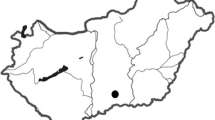Summary
The structure of cursorial spider assemblages was examined along a gradient of four temperature successional communities. Species diversity (H′), richness (S), and evenness (J′) exhibited a dichotomy between herbaceous and woody communities rather than a progressive change with community age: all three parameters were higher in the two younger fields than in the two older woodlands, which is contrary to conventional successional theory. Species importance curves were steeper in the two woody communities. The breadth of the distribution of adult body lengths was greater in the two herbaceous communities. Indices of community similarity revealed neither a successional trend nor the vegetative dichotomy. We suggest the hypothesis that habitat structure is a more important determinant of cursorial spider diversity than successional age per se, and that the switch in dominance from herbaceous to woody vegetation is the critical change. We further suggest that competition for prey is more important to cursorial spiders in early successional (herbaceous) communities, because of a switch in the limiting resource from prey in these communities to the amount of accumulating litter (a spatial resource) in older woody stands. This may explain the greater variation in adult body size of these generalist predators in the two younger communities.
Similar content being viewed by others
References
Bernays E, Graham M (1988) On the evolution of host specificity in phytophagous arthropods. Ecology 69:886–892
Brown VK (1982) The phytophagous insect community and its impact on early successional habitats. pp 205–213 in Visser JH, Minks AK (eds) Proc 5th Int Symp Insect-plant Rel
Brown VK (1985) Insect herbivores and plant succession. Oikos 44:17–22
Bultman TL, Uetz GW (1982) Abundance and community structure of forest floor spiders following litter manipulation. Oecologia 55:34–41
Bultman TL, Uetz GW (1984) Effect of structure and nutritional quality of litter on abundances of litter-dwelling arthropods. Am Midl Natur 111:165–172
Bultman TL, Uetz GW, Brady AR (1982) A comparison of cursorial spider communities along a successional gradient. J Arachnol 10:23–33
Chiverton PA (1986) Predator density manipulation and its effects on populations of Rhodopalosiphum padi (Homoptera: Aphididae) in spring barley. Ann Appl Biol 109:49–60
Connell JH (1978) Diversity in tropical rain forests and coral reefs. Science 199:1302–1310
Connell JH, Slatyer RO (1977) Mechanisms of succession in natural communities and their role in community stability and organization. Am Nat 111:1119–1144
Cornell HV, Hurd LE, Lotrich VA (1976) A measure of response to perturbation used to assess structural change in some polluted and unpolluted stream fish communities. Oecologia 23:335–342
Elton C (1927) Animal ecology. McMillan, New York
Fagan WF, Hurd LE (1991) Direct and indirect effects of generalist predators on a terrestrial arthropod community. Am Midl Nat 126:380–384
Greenstone MH (1984) Determinants of web spider species diversity: vegetation structural diversity vs. prey availability. Oecologia 62:299–304
Hairston NG, Smith FE, Slobodkin LB (1960) Community structure, population control, and competition. Am Natur 94:421–425
Hill MO (1973) Diversity and evenness: a unifying notion and its consequences. Ecology 54:427–432
Hurd LE (1988) Consequences of divergent egg phenology to predation and coexistence in two sympatric, congeneric mantids (Orthoptera: Mantidae). Oecologia 76:549–552
Hurd LE, Eisenberg RM (1990) Arthropod community responses to manipulation of a bitrophic predator guild. Ecology 71:2107–2114
Hurlbert SH (1984) Pseudoreplication and the design of ecological experiments. Ecol Monogr 54:187–211
Hutchinson GE (1959) Homage to Santa Rosalia or why are there so many kinds of animals? Am Nat 93:145–159
Karlson RH, Hurd LE (1992) Disturbance, coral reef communities, and changing ecological paradigms. Coral Reefs (in press)
Lawton JH, Strong DR (1981) Community patterns and competition in folivorous insects. Am Natur 118:317–338
McNaughton SJ, Wolf LL (1979) General ecology 2nd ed. Holt, Rinehart and Winston, New York
Odum EP (1969) The strategy of ecosystem development. Science 164:262–270
Pielou EC (1966) Species-diversity and pattern-diversity in the study of ecological succession. J Theor Biol 10:370–383
Pielou EC (1976) Population and community ecology: principles and methods. Gordon and Breach, New York
Riechert SE, Bishop L (1990) Prey control by an assemblage of generalist predators: spiders in garden test systems. Ecology 71:1441–1450
Schoener TW (1965) The evolution of bill size differences among sympatric congeneric species of birds. Evolution 19:189–213
Schoener TW, Toft CA (1983) Spider populations: extraordinarily high densities on islands without top predators. Science 219:1353–1355
Shannon and Weaver (1949) The mathematical theory of communication. Univ Illinois Press, Urbana
Shelford VE (1970) Preliminary notes on the distribution of the tiger beetles (Cicindela) and its relation to plant succession. Biol Bull 14:9–14
Simberloff D, Boecklen W (1981) Santa Rosalia reconsidered: size ratios and competition. Evolution 35:1206–1228
Strong DR, Simberloff D (1981) Straining at gnats and swallowing ratios: character displacement. Evolution 35:810–812
Uetz GW (1976) Gradient analysis of spider communities in a streamside forest. Oecologia 22:373–385
Uetz GA (1977) Coexistence in a guild of wandering spiders. J Anim Ecol 46:531–542
Uetz GW (1979) The influence of variation in litter habitats on spider communities. Oecologia 40:29–42
Uetz GW, Unzicker JD (1976) Pitfall trapping in ecological studies of wandering spiders. J Arachnol 3:101–111
Van Hook RI, Jr (1971) Energy and nutrient dynamics of spider and orthopteran populations in a grassland ecosystem. Ecol Monogr 41:1–26
Wise DH (1984) The role of competition in spider communities: insights from field experiments with a model organism. pp. 42–53 in Strong DR, Simberloff D, Abele LG, Thistle AB (eds) Ecological communities: conceptual issues and the evidence. Princeton Univ Press, Princeton
Author information
Authors and Affiliations
Rights and permissions
About this article
Cite this article
Hurd, L.E., Fagan, W.F. Cursorial spiders and succession: age or habitat structure?. Oecologia 92, 215–221 (1992). https://doi.org/10.1007/BF00317367
Received:
Accepted:
Issue Date:
DOI: https://doi.org/10.1007/BF00317367




